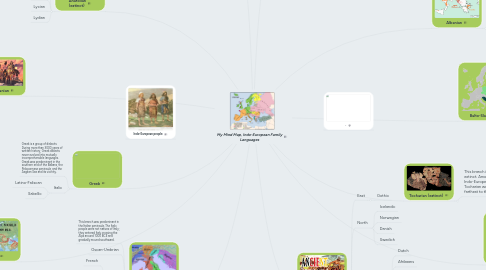My Mind Map, Indo-European Family Languages
por Daniela Meléndez


1. The Indo-European languages are a family of related languages that today are widely spoken in the Americas, Europe, and also Western and Southern Asia.
1.1. .
2. Romance (Italic)
2.1. This branch was predominant in the Italian peninsula. The Italic people were not natives of Italy; they entered Italy crossing the Alps around 1000 BCE and gradually moved southward.
2.2. Oscan-Umbrian
2.3. Latin
2.3.1. French
2.3.2. Italian
2.3.3. Spanish
2.3.4. Provencal
2.3.5. Portuguese
2.3.6. Catalan
2.3.7. Rumanian
3. Celtic
3.1. Celtic-speaking tribes had spread from what today are southern Germany, Austria, and Western Czech Republic in almost all directions, to France, Belgium, Spain, and the British Isles.
3.2. Irish Gaelic
3.3. Scottish Gaelic
3.4. Welsh
3.5. Breton
4. Indo-Iranian
4.1. Today these languages are predominant in India, Pakistan, Iran, and its vicinity and also in areas from the Black Sea to western China.
4.2. Indic
4.2.1. Sanskrist
4.2.1.1. Hindi
4.2.1.2. East
4.2.1.2.1. Gothic
4.2.1.3. Bengali
4.2.1.4. Marathi
4.3. Iranian
4.3.1. Ossetic
4.3.2. Pashtu
4.3.3. Farsi
4.3.4. Kurdish
4.3.5. Old Persian
4.3.6. Avestan
5. Anatolian (extinct)
5.1. All languages of this branch are currently extinct. This branch has the oldest surviving evidence of an Indo-European language, dated about 1800 BCE.
5.2. Hittite
5.3. Lycian
5.4. Lydian
6. Greek
6.1. Greek is a group of dialects: During more than 3000 years of written history, Greek dialects never evolved into mutually incomprehensible languages. Greek was predominant in the southern end of the Balkans, the Peloponnese peninsula, and the Aegean Sea and its vicinity.
6.2. Italic
6.2.1. Latino-Faliscan
6.2.2. Sabellic
7. Indo-European people
8. Armenian
8.1. The origins of the Armenian-speaking people is a topic still unresolved. It is probable that the Armenians and the Phrygians belonged to the same migratory wave that entered Anatolia, coming from the Balkans around the late 2nd millennium BCE.
9. Germanic
9.1. East
9.1.1. Gothic
9.2. North
9.2.1. Icelandic
9.2.2. Norwegian
9.2.3. Danish
9.2.4. Swedich
9.3. West
9.3.1. Low
9.3.1.1. Dutch
9.3.1.2. Afrikaans
9.3.1.3. Flemish
9.3.1.4. Frisian
9.3.1.5. English
9.3.2. High
9.3.2.1. German
9.3.2.2. Yiddish
9.4. The earliest evidence of Germanic-speaking people dates back to first half of the 1st millennium BCE, and they lived in an area stretching from southern Scandinavia to the coast of the North Baltic Sea.
10. The Indo-European languages have a large number of branches: Anatolian, Indo-Iranian, Greek, Italic, Celtic, Germanic, Armenian, Tocharian, Balto-Slavic and Albanian.
10.1. Indo-European
11. Balto-Slavic
11.1. The Balts' territory may have stretched from around western Poland all the way across to the Ural Mountains. Afterwards, the Balts occupied a small region along the Baltic Sea.
11.2. Baltic
11.2.1. Lithuanian
11.2.2. Latvian
11.2.3. Old Prussian
11.3. Stavonic
11.3.1. West
11.3.2. South
11.3.3. East
